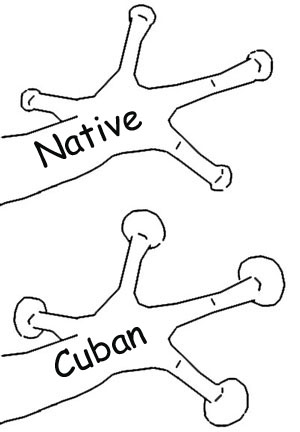Have you ever seen a large, warty, bug-eyed frog in your house or your backyard? It might be a Cuban treefrog, an invasive species in Florida.
What’s going on?
Florida is home to four nonnative frogs in Florida including the Cuban treefrog, which was accidentally brought to Florida in the 1920s. These frogs are native to Cuba, the Cayman Islands, and the Bahamas, and they have established populations in the Florida panhandle and peninsula. Cuban treefrogs are considered invasive because they harm the environment and cause problems for humans.
Cuban treefrogs eat at least five species of Florida’s native treefrogs and have been responsible for declines of some native treefrog species, especially in urban areas. Their tadpoles also compete with native treefrog tadpoles for space and have even preyed upon the tadpoles of native squirrel treefrogs. Although they are eaten by several species of native Florida snakes, Cuban treefrogs also have adaptations that help them avoid being eaten by predators. The frog’s toxic skin secretions make them less susceptible to drying out and less nutritious to predators.
Cuban treefrogs are also common in urban areas in tight, enclosed spaces such as behind storm shelters or vinyl siding. They also hide by lights on the walls of houses and wait to catch insects that are attracted to the lights. In addition to using homes as shelter, they also poop on walls and windows. If there are a lot of Cuban treefrogs in the area, their fecal deposits can become unsightly and leave ugly stains. Although they are not lethal to pets, the secretions of Cuban treefrogs can cause discomfort to dogs and cats that bite the frogs.
Why is it important?
Cuban treefrogs are an invasive species that harm the ecology of native Floridian treefrogs and the quality of human life. Hard freezes and other cold spells have somewhat limited the spread of Cuban treefrogs. However, as the climate warms, scientists predict that the range of the Cuban treefrog will increase to much of the southeastern United States.
How to identify.
-
 Large body size – if you find a treefrog larger than 3 inches, it’s almost certainly a Cuban treefrog.
Large body size – if you find a treefrog larger than 3 inches, it’s almost certainly a Cuban treefrog. - Obvious bug-eyed appearance.
- Warty skin – warts of varying sizes on the back and none on the top of the he ad.
- Yellowish wash where their front and rear legs are attached to their body.
- Color variation – creamy white to light brown.
- May have wavy darker markings on back.
- Stripes/bands on rear legs.
- Large toepads in comparison to native treefrogs.
What you can do.
Because Cuban treefrogs eat native frogs and other wildlife, it is important that we take action to manage them and reduce their negative impacts on our native species and on the quality of life of Floridians.
- If you find a Cuban Treefrog at your house, check the Cuban Treefrog range map and report sightings in new areas.
- Cover vent pipes on your roof to prevent Cuban treefrogs from accessing your plumbing system.
- Be sure you have correctly identified the Cuban treefrog before humanely euthanizing them.
- To humanely euthanize a Cuban treefrog:
- Capture it in a plastic bag to avoid contact with their skin secretions.
- Apply benzocaine (20%) to the back or belly of the frog. Benzocaine is common in first aid or burn sprays and toothache gels.
- Seal the bag and put it in the freezer for 24 hours.
- The next day, dispose of the bag.
Information from UF/IFAS and UF Department of Wildlife Ecology and Conservation.